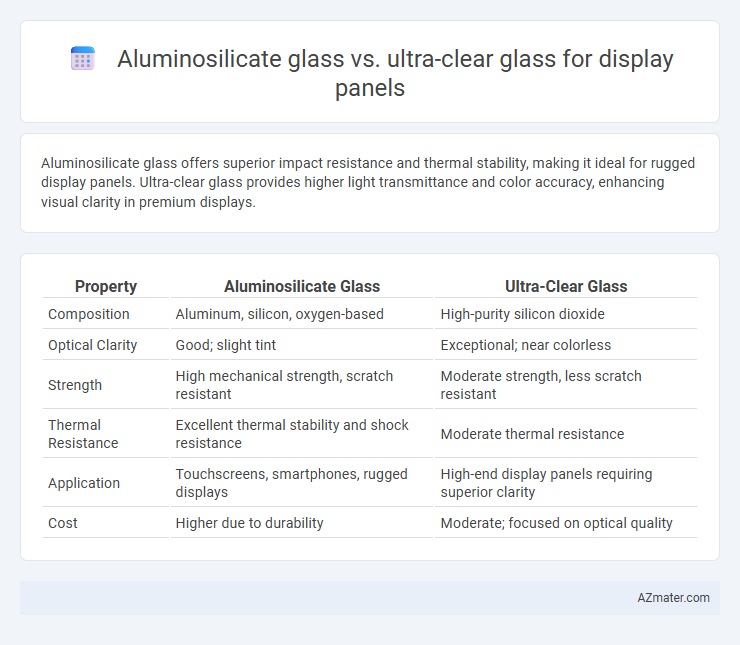Aluminosilicate glass offers superior impact resistance and thermal stability, making it ideal for rugged display panels. Ultra-clear glass provides higher light transmittance and color accuracy, enhancing visual clarity in premium displays.
Table of Comparison
| Property | Aluminosilicate Glass | Ultra-Clear Glass |
|---|---|---|
| Composition | Aluminum, silicon, oxygen-based | High-purity silicon dioxide |
| Optical Clarity | Good; slight tint | Exceptional; near colorless |
| Strength | High mechanical strength, scratch resistant | Moderate strength, less scratch resistant |
| Thermal Resistance | Excellent thermal stability and shock resistance | Moderate thermal resistance |
| Application | Touchscreens, smartphones, rugged displays | High-end display panels requiring superior clarity |
| Cost | Higher due to durability | Moderate; focused on optical quality |
Introduction to Display Panel Glass Types
Aluminosilicate glass is renowned for its high strength and excellent thermal resistance, making it ideal for display panels requiring durability and scratch resistance. Ultra-clear glass offers superior optical clarity with minimal green tint, enhancing the visual performance and color accuracy of display screens. Both glass types serve essential roles in modern display technology, where the choice depends on the balance between toughness and optical quality.
What is Aluminosilicate Glass?
Aluminosilicate glass is a type of chemically strengthened glass known for its high durability, scratch resistance, and ability to withstand thermal stress, making it ideal for display panels in smartphones and tablets. This glass composition includes aluminum oxide, which enhances its mechanical strength and resistance to impact compared to standard silica-based glass. Ultra-clear glass, on the other hand, emphasizes optical clarity and transparency but typically lacks the superior toughness and chemical resistance that aluminosilicate glass provides for protective display applications.
What is Ultra-clear Glass?
Ultra-clear glass, also known as low-iron glass, contains significantly reduced iron content compared to standard aluminosilicate glass, resulting in higher light transmission and minimal greenish tint. This characteristic makes ultra-clear glass ideal for display panels where true color representation and clarity are critical, such as in smartphones, tablets, and high-end monitors. Its advanced optical properties enhance screen visibility and color accuracy, outperforming traditional aluminosilicate glass in terms of transparency and aesthetics.
Optical Clarity: Aluminosilicate vs Ultra-clear Glass
Aluminosilicate glass offers high durability and scratch resistance but typically exhibits lower optical clarity compared to ultra-clear glass, which is engineered for superior light transmittance and minimal color distortion, making it ideal for display panels. Ultra-clear glass enhances visibility with a higher transmittance rate, often exceeding 90%, and reduces haze to maintain crisp image quality. In contrast, aluminosilicate glass, while robust, may have slightly lower light throughput around 85-90%, impacting the display's brightness and sharpness.
Strength and Durability Comparison
Aluminosilicate glass offers superior strength and impact resistance due to its enhanced chemical composition, making it highly resistant to scratches and thermal stress in display panels. Ultra-clear glass provides exceptional optical clarity with high transparency and reduced color distortion but generally has lower mechanical strength compared to aluminosilicate variants. For applications requiring maximum durability and protection against drops and abrasions, aluminosilicate glass remains the preferred choice in display technologies.
Scratch and Impact Resistance
Aluminosilicate glass offers superior scratch resistance due to its high hardness and chemical durability, making it ideal for protecting display panels in high-wear environments. Ultra-clear glass prioritizes optical clarity with reduced iron content but typically exhibits lower impact resistance compared to aluminosilicate variants. For applications demanding enhanced durability and long-lasting protection, aluminosilicate glass outperforms ultra-clear glass in resisting scratches and withstanding impact stress.
Light Transmission and Visual Performance
Aluminosilicate glass offers excellent mechanical strength and scratch resistance with light transmission rates around 90-92%, providing good visual clarity for display panels. Ultra-clear glass, often with iron content reduced to below 0.01%, delivers superior light transmission up to 93-95%, enhancing brightness and color accuracy for high-end displays. Reduced impurities in ultra-clear glass minimize haze and color distortion, making it ideal for applications requiring maximum optical performance.
Cost and Manufacturing Considerations
Aluminosilicate glass offers cost advantages due to its abundance and established manufacturing processes, making it a preferred choice for display panels requiring durability and scratch resistance. Ultra-clear glass, while providing superior optical clarity and enhanced brightness, incurs higher production costs associated with specialized raw materials and precision manufacturing techniques. Manufacturers must balance cost-efficiency and performance requirements when selecting between aluminosilicate and ultra-clear glass for display applications.
Applications in Modern Display Panels
Aluminosilicate glass offers superior strength and scratch resistance, making it ideal for touchscreen displays in smartphones, tablets, and rugged industrial devices. Ultra-clear glass provides exceptional optical clarity and light transmission, enhancing brightness and color accuracy in high-end monitors, televisions, and VR headsets. Both types contribute to advanced display technologies, with aluminosilicate preferred for durability and ultra-clear for visual performance.
Which Glass is Better for Your Display Panel?
Aluminosilicate glass offers superior scratch resistance and impact durability compared to ultra-clear glass, making it ideal for high-use display panels prone to physical stress. Ultra-clear glass provides enhanced optical clarity and color accuracy, which benefits displays requiring vibrant and true-to-life visuals. Selecting the best glass depends on whether durability or optical performance is the priority for your specific display panel use case.

Infographic: Aluminosilicate glass vs Ultra-clear glass for Display panel
 azmater.com
azmater.com